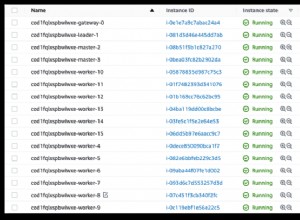Penso che questa sia una bella idea, ma devi farlo da solo, non c'è un supporto integrato per questo. Se hai un livello di accesso, puoi farlo lì. Avresti bisogno di una classe di attributi, qualcosa del genere;
public enum IndexConstraints
{
Normal = 0x00000001, // Ascending, non-indexed
Descending = 0x00000010,
Unique = 0x00000100,
Sparse = 0x00001000, // allows nulls in the indexed fields
}
// Applied to a member
[AttributeUsage(AttributeTargets.Property | AttributeTargets.Field)]
public class EnsureIndexAttribute : EnsureIndexes
{
public EnsureIndex(IndexConstraints ic = IndexConstraints.Normal) : base(ic) { }
}
// Applied to a class
[AttributeUsage(AttributeTargets.Class)]
public class EnsureIndexesAttribute : Attribute
{
public bool Descending { get; private set; }
public bool Unique { get; private set; }
public bool Sparse { get; private set; }
public string[] Keys { get; private set; }
public EnsureIndexes(params string[] keys) : this(IndexConstraints.Normal, keys) {}
public EnsureIndexes(IndexConstraints ic, params string[] keys)
{
this.Descending = ((ic & IndexConstraints.Descending) != 0);
this.Unique = ((ic & IndexConstraints.Unique) != 0); ;
this.Sparse = ((ic & IndexConstraints.Sparse) != 0); ;
this.Keys = keys;
}
}//class EnsureIndexes
È quindi possibile applicare gli attributi a livello di classe o di membro come segue. Ho scoperto che l'aggiunta a livello di membro aveva meno probabilità di non essere sincronizzata con lo schema rispetto all'aggiunta a livello di classe. Ovviamente devi assicurarti di ottenere il nome dell'elemento effettivo anziché il nome del membro C#;
[CollectionName("People")]
//[EnsureIndexes("k")]// doing it here would allow for multi-key configs
public class Person
{
[BsonElement("k")] // name mapping in the DB schema
[BsonIgnoreIfNull]
[EnsureIndex(IndexConstraints.Unique|IndexConstraints.Sparse)] // name is implicit here
public string userId{ get; protected set; }
// other properties go here
}
e quindi nella tua implementazione (o repository) di accesso al DB, hai bisogno di qualcosa del genere;
private void AssureIndexesNotInlinable()
{
// We can only index a collection if there's at least one element, otherwise it does nothing
if (this.collection.Count() > 0)
{
// Check for EnsureIndex Attribute
var theClass = typeof(T);
// Walk the members of the class to see if there are any directly attached index directives
foreach (var m in theClass.GetProperties(BindingFlags.Public | BindingFlags.NonPublic | BindingFlags.Instance | BindingFlags.FlattenHierarchy))
{
List<string> elementNameOverride = new List<string>(1);
EnsureIndexes indexAttr = null;
// For each members attribs
foreach (Attribute attr in m.GetCustomAttributes())
{
if (attr.GetType() == typeof(EnsureIndex))
indexAttr = (EnsureIndex)attr;
if (attr.GetType() == typeof(RepoElementAttribute))
elementNameOverride.Add(((RepoElementAttribute)attr).ElementName);
if ((indexAttr != null) && (elementNameOverride.Count != 0))
break;
}
// Index
if (indexAttr != null)
{
if (elementNameOverride.Count() > 0)
EnsureIndexesAsDeclared(indexAttr, elementNameOverride);
else
EnsureIndexesAsDeclared(indexAttr);
}
}
// Walk the atributes on the class itself. WARNING: We don't validate the member names here, we just create the indexes
// so if you create a unique index and don't have a field to match you'll get an exception as you try to add the second
// item with a null value on that key
foreach (Attribute attr in theClass.GetCustomAttributes(true))
{
if (attr.GetType() == typeof(EnsureIndexes))
EnsureIndexesAsDeclared((EnsureIndexes)attr);
}//foreach
}//if this.collection.count
}//AssureIndexesNotInlinable()
GuaranteeIndexes appare quindi così;
private void EnsureIndexesAsDeclared(EnsureIndexes attr, List<string> indexFields = null)
{
var eia = attr as EnsureIndexes;
if (indexFields == null)
indexFields = eia.Keys.ToList();
// use driver specific methods to actually create this index on the collection
var db = GetRepositoryManager(); // if you have a repository or some other method of your own
db.EnsureIndexes(indexFields, attr.Descending, attr.Unique, attr.Sparse);
}//EnsureIndexes()
Nota che lo posizionerai dopo ogni aggiornamento perché se dimentichi da qualche parte i tuoi indici potrebbero non essere creati. È importante quindi assicurarsi di ottimizzare la chiamata in modo che ritorni rapidamente se non è necessario eseguire l'indicizzazione prima di esaminare tutto il codice di riflessione. Idealmente, lo faresti solo una volta, o almeno, una volta per l'avvio dell'applicazione. Quindi un modo sarebbe usare un flag statico per tenere traccia se l'hai già fatto, e avresti bisogno di una protezione aggiuntiva per il blocco, ma in modo troppo semplicistico, sembra qualcosa del genere;
void AssureIndexes()
{
if (_requiresIndexing)
AssureIndexesInit();
}
Quindi questo è il metodo che vorrai in ogni aggiornamento del DB che fai, che, se sei fortunato, verrebbe integrato anche dall'ottimizzatore JIT.




